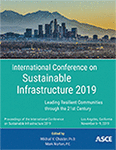International Conference on Sustainable Infrastructure 2019
A Probabilistic Approach to Determine Adequate Concrete Cover for Desired Service Life of RC Infrastructure in Corrosion Prone Environment
Publication: International Conference on Sustainable Infrastructure 2019: Leading Resilient Communities through the 21st Century
ABSTRACT
Requisite durability concerns of infrastructure often get undermined against strength considerations in prevalent construction practices of Bangladesh. A dominant factor behind durability and sustainability degradation of reinforced concrete (RC) structures has been chloride induced corrosion. The associated risk is largely dependent on concrete cover, which affects the ultimate serviceability of RC structures in corrosion prone environment. However, local guideline lacks specific directives on deducing adequate cover to ensure desired lifespan in different severe corrosion exposures. Hence, a probabilistic approach has been adopted to determine specific covers for ubiquitous concrete mixes with different water-cement ratios and cement type for a set of service lives and exposure conditions. Based on chloride diffusion coefficients from migration test, cover values have been determined while considering a fixed target time to initiate corrosion. The findings reveal significant impact of exposure condition on cover requirement, with magnitudes beyond recommended values in general guidelines of local codes, which urge special consideration to achieve desired service life. The obtained outcomes of this study manifest an immense scope as a preliminary quantitative guideline for necessary cover determination in order to safeguard the sustainability of RC infrastructure.
Get full access to this chapter
View all available purchase options and get full access to this chapter.
ACKNOWLEDGEMENT
This work has been carried out in the Department of Civil Engineering, Bangladesh University of Engineering and Technology (BUET). The authors gratefully acknowledge the support and facilities provided by the Department of Civil Engineering, BUET.
REFERENCES
Alghamdi, S.A., and Ahmad, S.(2014). "Service life prediction of RC structures based on correlation between electrochemical and gravimetric reinforcement corrosion rates." Cement & Concrete Composites, 47, 64–68.
Alonso, C., Andrade, C., Castellote, M., and Castro, P. (2000). "Chloride threshold values to depassivate reinforcing bars embedded in a standardized OPC mortar." Cem. Concr. Res., 30, 1047–1055.
Angst, U. (2011) “Chloride induced reinforcement corrosion in concrete: Concept of critical chloride content – methods and mechanisms”, Ph.D. thesis, Department of Structural Engineering, Norwegian University of Science and Technology.
Baten, B., Hasan, M.J., Bose, B., and Manzur, T. (2016). "Corrosion Potential of Stone and Brick Aggregate Concrete in the Context of Bangladesh." 1st Bangladesh Civil Engineering Summit, Dhaka, Bangladesh. ISBN 978-984-34-1512-7.
DARTS (2004). “Durable and Reliable Tunnel Structures: Deterioration Modelling, EuropeanCommission, Growths 2000,” Contract G1RD-CT-2000-00467, Project GrD1-25633.
DuraCrete (1998) “Modelling of Degradation, DuraCrete - Probabilistic Performance based Durability Design of Concrete Structures”, EU - BriteEuRam III, Contract BRPR-CT95-0132, Project BE95-1347/R4-5, 174 p.
ElMaaddawy, T., and Soudki, K.A. (2007) “A Model for Prediction of Time from Corrosion Initiation to Corrosion Cracking.” Cement & Concrete Composites, 29(3): 168-175.
EN 206 (2013). “Concrete: Specification, performance, production and conformity.” British Standard.
Fib Bulletin 34 (2006). “Model Code for Service Life Design”, Lausanne.
Fib Bulletin 76 (2015) “Benchmarking of deemed to satisfy provisions in standards: durability of reinforced concrete structures exposed to chlorides”, Lausanne.
Hasan, M. J. (2018) “Service life prediction for different types of concrete using chloride diffusion coefficients”, M.Sc. Thesis, Bangladesh University of Engineering and Technology, Dhaka.
Lai, W., Kind, T., Stoppel, M. and Wiggenhauser, H. (2013). "Measurement of Accelerated Steel Corrosion in Concrete Using Ground-Penetrating Radar and a Modified Half-Cell Potential Method." Journal of Infrastructure Systems, 19(2): 205-220.
Lizarazo-Marriaga, J. and Claisse, P. (2009). “Determination of the concrete chloride diffusion coefficient based on an electrochemical test and an optimization model.” Materials Chemistry and Physics, 117(2-3):536-543.
Manzur, T., Baten, B., Hasan, M.J., and Bose, B. (2017). “Application of Corrosion Potential as a Tool to Assess Sustainability of Indigenous Concrete Mixes in Bangladesh.” International Conference on Sustainable Infrastructure, ASCE.
Manzur, T., Baten, B., Hasan, M.J., Akter, H., Tahsin, A., and Hossain, K. M. A. (2018) “Corrosion Behaviour of Concrete Mixes With Masonry Chips”, Construction and Building Material, 185: 20-19.
Mashrur, N., Shishir, N. A., Islam, M. W., Sehab, Z. H., Hasan, M. J., and Manzur, T. (2018). “Chloride Diffusion Coefficients f Some Common Concrete Mixes Of Bangladesh.” 4th International Conference on Advances in Civil Engineering 2018 (ICACE 2018), CUET, Chittagong, Bangladesh
MATLAB Documentation (2012). “Functions in MATLAB.”TheMathworks Inc., USA. https://www.mathworks.com/product/matlab.html.
Mullard, J.A., and Stewart, M.G. (2009) “Corrosion-Induced Cover Cracking of RC Structures: New Experimental Data and Predictive Models”, Research Report No. 275.01.2009, Centre for Infrastructure Performance and Reliability, The University of Newcastle, NSW, Australia.
NT BUILD 492 (1999) “Concrete, Mortar and Cement Based Repair Materials: Chloride Migration Coefficient from Non-Steady State Migration Experiments.” Nordtest method, Finland.
Samson, E., Marchand, J. and Snyder, K. A. (2003). “Calculation of ionic diffusion coefficients on the basis of migration test results.” Materials and Structures, 36:156-165.
Torsha, T., Khan, M. F.A., Hasan, M. J., Mutsiddy, R., and Manzur, T. (2019). “Tentative Design Life of Reinforced Concrete Structures: Bangladesh Perspective.” International Conference on Disaster Risk Management, Dhaka.
Wang, X., Nguyen, M., Stewart, M.G., Syme, M., and Leitch, A. (2010). “Analysis of Climate Change Impacts on the Deterioration of Concrete Infrastructure – Part 1: Mechanisms, Practices, Modelling and Simulations – A review”, CSIRO, Canberra.
Information & Authors
Information
Published In
International Conference on Sustainable Infrastructure 2019: Leading Resilient Communities through the 21st Century
Pages: 163 - 174
Editors: Mikhail V. Chester, Ph.D., Arizona State University, and Mark Norton, Santa Ana Watershed Project Authority
ISBN (Online): 978-0-7844-8265-0
Copyright
© 2019 American Society of Civil Engineers.
History
Published online: Nov 4, 2019
Authors
Metrics & Citations
Metrics
Citations
Download citation
If you have the appropriate software installed, you can download article citation data to the citation manager of your choice. Simply select your manager software from the list below and click Download.
